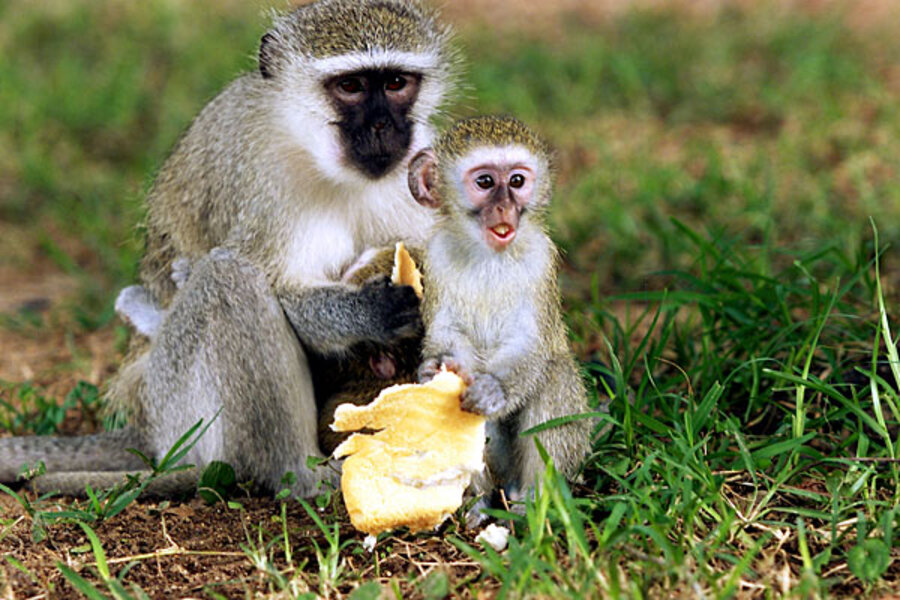Monkeys imitate local food norms, study finds
Loading...
The tendency to adapt to cultural behaviors in a new place is not unique to us, a new study suggests.
A study led by psychologists of the University of St Andrews in Scotland finds that vervet monkeys (Chlorocebus aethiops) in South Africa prefer food that those around them are eating.
The researchers dyed corn pink or blue and trained groups of monkeys to eat corn of one color and avoid the other. When young males migrated from one group to a group that preferred the opposite color, most of them immediately switched to the local preference.
Leading primate experts call this research evidence of "cultural transmission" in wild primates, which could also help to explain the evolution of our human desire to search for "local knowledge" when traveling to a new culture.
In a press release from St Andrews, noted primatologist Frans de Waal called the research "one of the few successful field experiments on cultural transmission to date.” De Waal did not participate in the study.
Carel van Schaik, an evolutionary anthropologist at the University of Zurich, was also impressed. "Culture was thought to be something only humans had” he told the New York Times. "If you define culture as socially transmitted knowledge, skills and information, it turns out we see some of that in animals. Now this experiment comes along and I must say it really blew me away.”
According to the study's authors, the discovery demonstrates that social learning and cultural conformity play an important role in the behavior of animals as well as humans.
"As the saying goes, 'When in Rome, do as the Romans do,'" said co-author Andrew Whiten in the St Andrews press release. "Our findings suggest that a willingness to conform to what all those around you are doing when you visit a different culture is a disposition share by other primates."
The study was published on April 25 by the journal Science.
Whiten and his colleagues conducted field experiments at the Inkawu Vervet Project in the Mawana private game reserve in South Africa. At first, they induced conformity in four groups of wild vervet monkeys with 109 animals in total.
The team fed the first two groups of monkeys with a box of corn dyed blue and another dyed pink. The blue corn was soaked in bitter aloe leaves and to be made distasteful to the monkeys, so they soon ate only pink corn. For two other groups, pink corn was made bitter, and the monkeys learned to prefer blue corn. Once the monkeys were trained, the researchers stopped adding the aloe to the corn.
Four months later, 27 infants were born. When they were able to eat solid food, the researchers supplied baby and adult monkeys with blue and pink corn. The adult animals stuck to their favorite color, and 26 of the infants ate only the corn the adult monkeys liked.
During the mating season, 10 male monkeys joined other groups that ate corn with a color different from the one their native group did. What surprised the researchers was that seven migrants quickly took up the locally-preferred corn, suggesting that they conformed to the cultural norm of their new group. With no higher ranking monkey present, the other two soon followed suit.
Researchers said the single monkey who continued to choose the same color as in his original group was perhaps taking the top rank in his new group, a factor that might explain his nonconformist behavior.
“The willingness of the immigrant males to adopt the local preference of their new groups surprised us all," said co-author Erica van de Waal, in the press release. "The copying behaviour of both the new, naïve infants and the migrating males reveals the potency and importance of social learning in these wild primates, extending even to the conformity we know so well in humans.”
She said the study was one of the very few successful controlled experiments in the wild, which "hints at a level of conformism most of us, until now, held not possible."
The cultural learning ability discovered in vervet monkeys is reminiscent of a well-known study of Japanese macaques in the 1950s, in which one monkey was observed washing her food, a practice that spread throughout the troop and was passed on to subsequent generations.
Monkeys aren't the only animals observed transmitting cultural information. Another study conducted by a different group of scientists at the University of St Andrews found that whales learned feeding techniques from their peers. Through analysis of a 27-year database on whale behavior collected in the Stellwagen Bank National Marine Sanctuary, the researchers find that lobtail feeding had spread to 37 percent of the whale's population.
Susan Perry, an anthropologist at the University of California, Los Angeles, finds the whale study to be "a highly convincing case for a foraging tradition in a cetacean."






